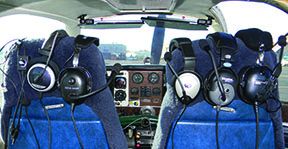Got $1200 to spend on a headset? That’s what you’ll have to pony up for a Bluetooth-equipped Bose A20—a high-end model that easily ranks at the top of the ANR food chain. Don’t get us wrong—we think the flagship Bose A20 continues to set the standard by which all other aviation headsets are judged. If we had the dough, we’d buy a set for every seat.
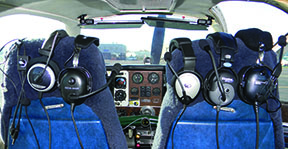
On the other hand, our recent sampling of a half dozen lower-cost models proved that there are worthy alternatives. Whether it’s a spare set to toss around the back cabin or for primary use in the left seat, we found a variety of models that offer solid performance without draining the budget.
OUR EVALUATION
We reeled in over a dozen ANR models to test—and even that didn’t cover the entire market. While we used every one of them, there’s no way we could effectively report on so many models in one article. Instead, we consulted with retailers who sell a lot of headsets, including the folks at Gulf Coast Avionics, who graciously sent us some models they think represent the current buying trend in budget ANR. We also talked with Sporty’s, for their view of the market. Last, we surveyed a handful of buyers who had their sights on particular brands. Ultimately, we chose six models, the lowest-priced unit selling for around $200 with the highest-price model discounted to $799. The sample group included one unique, non-ANR model.
Our testing process was basic—we tested them the way you would use them in the real world. We skipped geeky lab analysis and complicated audio engineering data. Instead, we assembled a diverse test group of a half-dozen active pilots and handed these things out like candy on Halloween. Our group included flight instructors, charter pilots, go-places aircraft owners and even maintenance technicians, who use headsets every day for ground and flight testing. We also passed them to back seat passengers, including picky teenagers. Some of the pilots in our sample group own the high-priced Bose A20—which escalated expectations. Without revealing sell prices, we asked our testers how much they would pay for each model, if they would buy them. Each tester was given an evaluation checklist that, on a four-point scale—poor, fair, good, excellent—rated four major categories, to include comfort, styling, audio performance and durability. We then took the average of all the categories and issued each model a final overall score.
COMFORT FOR ALL
We learned early in our testing that headset evaluation is subjective, particularly when it comes to comfort. For example, good fit and comfort for one pilot was excellent to another. For instance, one tester always flies with a ball cap, so he graded comfort based on the pressure point at the top of the hat. Another always flies with earrings, so she focused on how the ear cups pressed the earrings.
The other subjective and mission-specific category was durability and for this, we listened closely to the flight instructors in our group. They plug and unplug these things many times every day, toss them on top of cowlings and wings and hastily shove them into their flight bags. Like some of our testers, if your headset never leaves your airplane, you don’t subject them to such rigor.
Our advice is to buy a headsetfrom a vendor that can offer an exchange, if it turns out you don’t get along with it.
LIGHTSPEED SIERRA
While we hate to spoil a surprise, the Lightspeed Sierra was the hands- down favorite of every tester in our group. The Sierra weighs in at 16 ounces and has a high-quality and rugged feel, in our view. It also earned cheers for comfort, much in part for its oblong headband design that limits clamping pressure.
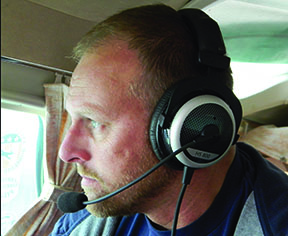
The Sierra is one of the higher-priced models in the sample group, street-priced at around $600. We think it’s a good value, given a long list of standard features. These include an integrated cell phone Bluetooth interface that at times flunked the pairing test—ignoring more than one iPhone handshake. It also has a stereo music input, but you’ll have to hard-connect a music device because the wireless Bluetooth only works for telephone input. Speaking of music, the headset has a smart music muting function that lowers the music volume for incoming radio transmissions. The set runs on two AA batteries that should last upwards of 40 hours. There’s auto-shutoff, a low battery indicator and accurate dual volume controls that are built into a modern control module that earned cheers for having a sturdy, high-end feel.
There were a couple of complaints on the Sierra’s performance when the ANR circuitry was shut off. More than one tester noted that this passive use created muffled phone audio. “I wouldn’t want to fly with these long distance without the ANR,” said one tester. On a side note, we’ve used the Bose A20 with the ANR circuitry turned off, and had similar results. Lightspeed throws in a sturdy, padded carry case, music patch cable and a five- year warranty.
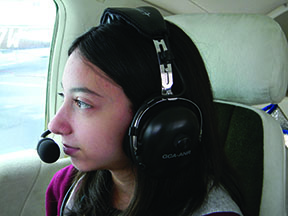
TELEX STRATUS 30XT
With a focus on battery power management, the 18-ounce Telex 30XT earned a reputation in our test group for its durable and handsome design. It feels sturdy, too, with rubber-capped volume controls that are located on each ear cup. Speaking of ear cups, the cups on the 30XT offered a solid seal on ears of all sizes without excessive clamping pressure. The Telex offers three adjustable pressure clamping settings with its Comfort Cam lever, where dialing in more pressure offers a tighter seal on the ear and increased noise reduction. The obvious trade-off here, which we confirmed while wearing sunglasses, is less comfort. We noted ANR circuitry-induced white noise with the Stratus, but this went unnoticed after engine start in our test Bonanza, which was equipped with a Garmin GMA340 audio panel. Microphone audio performance was accurate while the phone audio was a bit trebly, as one tester commented. We took the 30XT on a multi-hour trip and hardly noticed that they were on our head. We especially liked the sturdy microphone boom and thick wind muff.
The 30XT runs on two supplied NiMH rechargeable batteries that we found to have good endurance, although for long trips, we prefer to use Alkalines, which the unit can accommodate. Telex supplies a variety of wall charging plugs, music input patch cable and a headset storage bag that proved to be way too small.
FLIGHTCOM VENTURE 90
The V90 got high scores for durability, particularly for the washable polar-fleece head pad and thick leather ear seals. It ranked high for modern styling, with its carbon fiber print design on the ear cups. The 17-ounce V90 also scored we’ll for its control module, which is both durable and functional, with an accurate battery life annunciator. But for audio performance, our testers carried them in with mixed results. “There was an odd background noise present in the phone audio,” said one, while another reported that the microphone audio had a tendency to clip. The dual, earcup-mounted volume controls, however, worked with linear accuracy
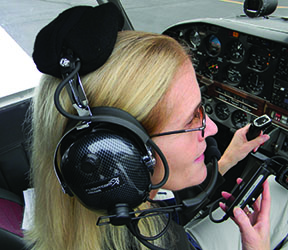
The V90 comes with generous auxiliary input capability, including dedicated music and telephone audio that automatically mutes with incoming radio communications. The headset runs on two AA batteries that are preserved by an automatic shut-off circuit that Flightcom calls the Sure Power System—chopping the power after 15 minutes of lifeless audio.
There’s no Bluetooth on the V90, but instead, a cable-required cellphone interface jack, which worked we’ll in our trials, as did the auxiliary input jack for music input. Street-priced at around $430, we think the V90 could be a better headset if it had a slightly smaller profile and loses the old-fashioned metal frame.
GULF COAST GCA-ANR
The $205 GCA-ANR was the least expensive set in our group. It held its own against models that cost nearly three times as much. It weighs 19 ounces and while some of our testers complained of the headset’s clamping pressure, it fit comfortably on smaller heads. While marketed as an entry-level model, it doesn’t skimp on useful features including a stereo and mono select switch, automatic shutoff, plus cell phone and music input interface. Gulf Coast says the two AA batteries can power the ANR circuitry for 30-40 hours. The headset comes with gel ear seals and ear seal covers. The ANR control module has a no-frills feel but for an ANR that sells for under $200 and performs to reasonably high standards, we’re not complaining.
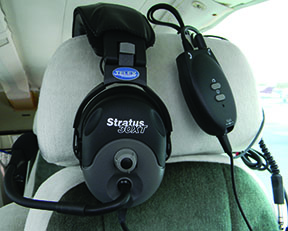
BEYERDYNAMIC HS800
To many, Beyerdynamic is an unfamiliar name in the aviation headset arena. Founded in Berlin in 1924, the company developed dynamic studio microphones in the late 1930s and in 2008 developed the first aviation headset with DANR, which is Digital Adaptive Noise Reduction. Digitally-controlled ANR circuitry uses high-speed clocked microprocessors which, according to the company, combines feedback and feedforward algorithms for a noise reduction performance found in no other aviation headset.
How did it perform in our testing? Quite well, although we initially had some doubts. Energizing the ANR circuitry in the HS800 produces a noticeable digital-like white noise, which the company describes as a counternoise to unwanted noise. We couldn’t quite wrap our heads around the theory but we can attest to excellent noise-cancelling qualities, which is what matters the most. Speaking of head-wrapping, most of our testers spotted the set’s obvious quality finish. The genuine leather-wrapped earcup and headband surfaces reek—literally, of high-quality leather. “They smell like the leather interior in my BMW and are just as comfy,” noted one tester. But some of the testers noted more clamping pressure than they would like.“They are far from uncomfortable, but I wouldn’t give up my Bose A20s for them,” said one tester.
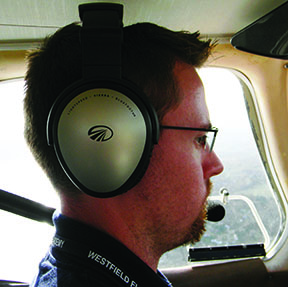
Battery endurance of two AA alkalines is fair, lasting 25 hours and are preserved by automatic shutoff. Strutting its studio roots, the HS800 offered the best music input quality of any in the group—with a bass reflex system that rivals high-end audio control panels, while a selectable music automute circuit stifles the input when you don’t want to miss a radio call. As much as we liked the HS800, we think buyers should demand a Bluetooth from a headset that’s priced at nearly $800.
WRAP IT UP
We started this review expecting the German-made Beyerdynamic HS800 to come up on top, based on its price. We shopped mail-order retailers and found the HS800 discounted to $799, but it was still the most expensive in our group. While we think it pushes the boundaries of budget pricing, we used it as a benchmark, based on price. Did it live up to its high price tag? We think so, with fine fit, finish and exceptional ANR. Speaking of music, the HS800 will deliver serious hi-fi on the fly—better than any in the group. Still, our test group still preferred the Lightspeed Sierra, which sells for $200 less. Based on its performance, comfort, features and styling, we declare it a solid winner—with the Telex 30XT winning a close second, based on their overall performance, build quality, comfort and value.
Last, we think you’ll be happy with any of the units we sampled, but as with any headset, you really need to try them before you buy them.

